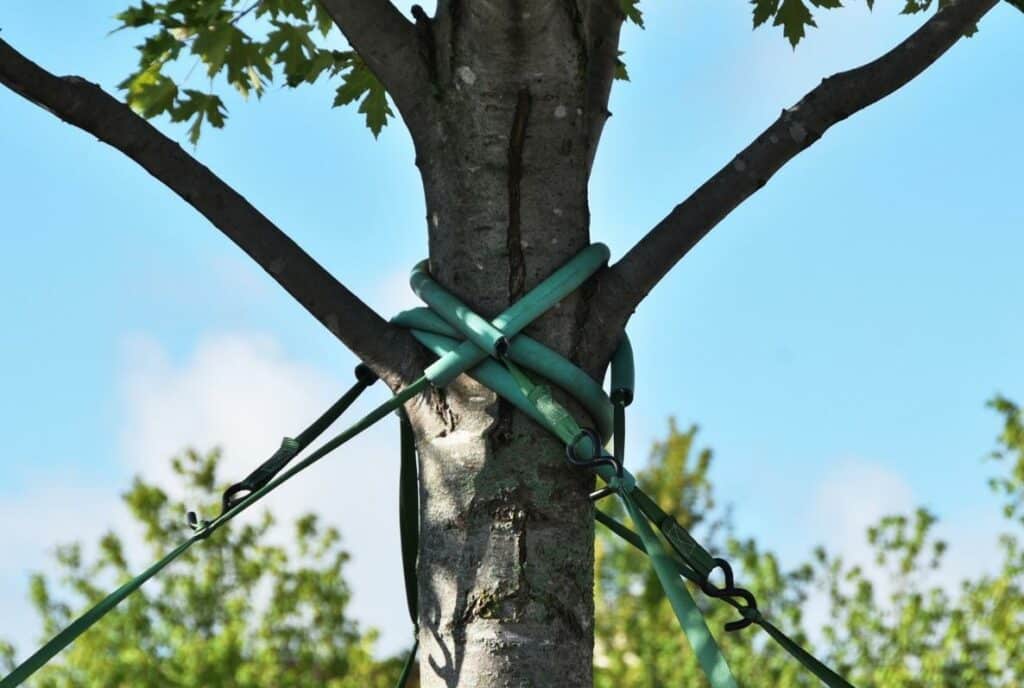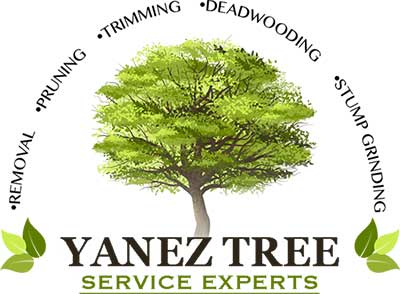
Trees are an asset to any property. The benefits of having trees on your property are innumerable; such as they boost curb appeal, increase your property’s value, provide shade, improve the air quality, etc. However, when trees become ill or sustain damage, they can pose risks to homes, cars, power lines, people, and pets. Damage to the root system strips trees of their means of support. Damage to the trunk can leave a tree vulnerable to snapping under the weight of heavy snow or in high winds.
Fortunately, tree cable bracing can significantly reduce the risk of a tree structure breaking under pressure.
What Is Tree Cabling and Bracing?
Tree cabling and bracing are techniques for protecting lives and property from unstable trees. They do more than prop up the tree.
Like casting a broken bone, cabling and bracing trees limit the movement of limbs. As a result, they create conditions that allow them to heal naturally.
The Yanez Tree Service Experts specialize in tree cabling and bracing. Our team wants to raise awareness of tree cabling and bracing techniques in the Rockville, MD, community. If you’re wondering, “What is tree cabling and bracing?” and “What can tree cabling and bracing offer me?” we have answers.
How to Cable a Tree
Cabling is a method for preventing weak branches from snapping if they are dead, damaged, or otherwise unable to support themselves without assistance. The two most common cabling systems involve using cables to connect different branches of the same tree. The third system involves cabling with a guy wire to connect the tree to an external source of support.
The material you use for cabling impacts its effectiveness. Most traditional cabling techniques use steel cable, which is a static material. It does not stretch as the wind pushes against it or snow puts weight on its branches.
Living, healthy trees can withstand natural forces because their trunks and branches can flex and bend. Newer extra high-strength cable materials mimic the flexibility of natural trees. This “dynamic cabling” allows branches to bend with the wind.
Connecting the branches through cabling is most effective when the tree can support itself. If it is unstable, the cables will not support it unless they attach to something else, like a post.
However, tree cabling cannot reverse any damage that causes the entire tree to lean. Instead, the trunk and roots need more support. If a tree is leaning or its roots will not support it, you might need other techniques such as bracing or staking.
Tree Bracing
Bracing is a technique that increases the stability of weak branches or the union of two branches by driving a rod through the tree. The bracing rod has a screw or bolt to hold it in place. The bracing rods prevent the trees from structural failure such as tearing apart or moving too much in storms.
Bracing prevents the tree from splitting or a large branch from falling off. It preserves structural integrity by supporting the branches. Over time, its split parts could grow back together, allowing the weak structure to regain its strength.
Bracing a Leaning Tree
Bracing a leaning tree by connecting it to the ground is one way to allow the roots to stabilize. The experts at the Yanez Tree Service team can support the tree by tying the tree to stakes that attach to the ground. We can also brace the tree with supports that anchor it to the ground.
Some experts do not recommend staking as a solution for leaning trees. Instead, they prefer to support the root and trunk in other ways. There are several reasons to avoid staking trees:
- A staked tree can become less stable because it depends on the stake to remain upright.
- The rope that ties the stake to the tree can seriously damage the limbs.
- Staking does not solve the underlying problem causing the tree to lean.
There are other ways to straighten a leaning tree. Trees often lean because they do not have enough support from their root system.
Therefore, one approach involves digging a trench around the tree to allow the root system to move and then pull it into a more stable position. When you replace the soil over the roots, it will help keep them in place and allow them to grow in a way that keeps the tree upright.
Professional Cable Tree Service in Rockville, MD
Acting early to protect damaged trees can help your trees weather strong winds, violent weather and other kinds of damage. Yanez Tree Service Experts are experienced and dependable providers of Tree Cable Bracing services.
We use the latest technology and practical knowledge to protect the support systems and preserve their structural integrity. Our inspectors will identify weak areas and develop a practical support and treatment plan to improve the tree’s health and tree safety.
For top-quality tree cabling and bracing service, call (301) 503-9806 today. Schedule a thorough inspection or ask us questions about tree cabling and bracing.


No Comments